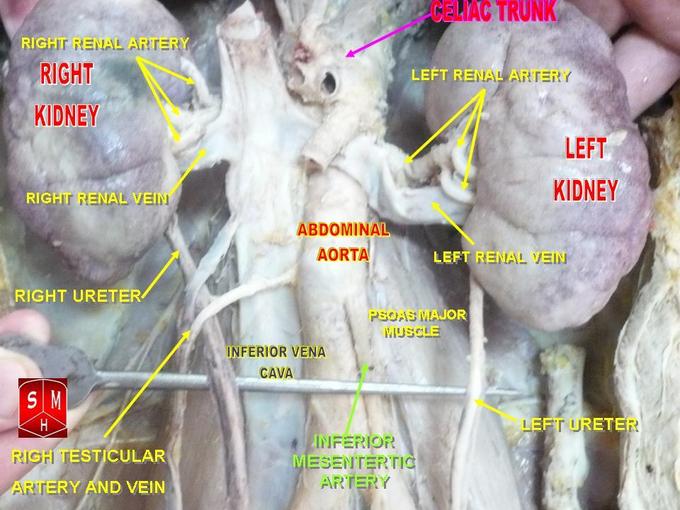24.2C: Supply of Blood and Nerves to the Kidneys
- Page ID
- 8137
The renal veins drain the kidney and the renal arteries supply blood to the kidney.
- Summarize the blood and nerve supply of the kidney
Key Points
- The renal arteries branch off of the abdominal aorta and supply the kidneys with blood. The arterial supply of the kidneys varies from person to person, and there may be one or more renal arteries to supply each kidney.
- The renal veins are the veins that drain the kidneys and connect them to the inferior vena cava.
- The kidney and the nervous system communicate via the renal plexus. The sympathetic nervous system will trigger vasoconstriction and reduce renal blood flow, while parasympathetic nervous stimulation will trigger vasodilation and increased blood flow.
- Afferent arterioles branch into the glomerular capillaries, while efferent arterioles take blood away from the glomerular capillaries and into the interlobular capillaries that provide oxygen to the kidney.
Key Terms
- renal artery: These arise off the side of the abdominal aorta, immediately below the superior mesenteric artery, and supply the kidneys with blood.
- renal vein: The veins that drain the kidney and connect the kidney to the inferior vena cava.
Because the kidney filters blood, its network of blood vessels is an important component of its structure and function. The arteries, veins, and nerves that supply the kidney enter and exit at the renal hilum.
Renal Arteries
The renal arteries branch off of the abdominal aorta and supply the kidneys with blood. The arterial supply of the kidneys is variable from person to person, and there may be one or more renal arteries supplying each kidney.
Due to the position of the aorta, the inferior vena cava, and the kidneys in the body, the right renal artery is normally longer than the left renal artery. The renal arteries carry a large portion of the total blood flow to the kidneys—up to a third of the total cardiac output can pass through the renal arteries to be filtered by the kidneys.
Renal blood supply starts with the branching of the aorta into the renal arteries (which are each named based on the region of the kidney they pass through) and ends with the exiting of the renal veins to join the inferior vena cava. The renal arteries split into several segmental arteries upon entering the kidneys, which then split into several arterioles.
These afferent arterioles branch into the glomerular capillaries, which facilitate fluid transfer to the nephrons inside the Bowman’s capsule, while efferent arterioles take blood away from the glomerulus, and into the interlobular capillaries, which provide tissue oxygenation to the parenchyma of the kidney.
Renal Veins
The renal veins are the veins that drain the kidneys and connect them to the inferior vena cava. The renal vein drains blood from venules that arise from the interlobular capillaries inside the parenchyma of the kidney.
Renal Plexus
The renal plexus are the source of nervous tissue innervation within the kidney, which surround and primarily alter the size of the arterioles within the renal cortex. Input from the sympathetic nervous system triggers vasoconstriction of the arterioles in the kidney, thereby reducing renal blood flow into the glomerulus.
The kidney also receives input from the parasympathetic nervous system, by way of the renal branches of the vagus nerve (cranial nerve X), which causes vasodilation and increased blood flow of the afferent arterioles. Due to this mechanism, sympathetic nervous stimulation will decrease urine production, while parasympathetic nervous stimulation will increase urine production.

Blood supply to the kidneys: The renal arteries branch off of the abdominal aorta and supply the kidneys with blood.

